Generally speaking, I treat the subject of power the same way as I treat pretty much any aspect of personal ownership, e.g. with guns:
“Why do you need such a powerful gun?” — Because I want it, and because MYOFB.
However, I am somewhat at a loss when it comes to modern cars, which to me seem terribly over-powered relative to the average driver’s ability to pilot the thing, e.g. the 1,000hp Bugatti Veyron:
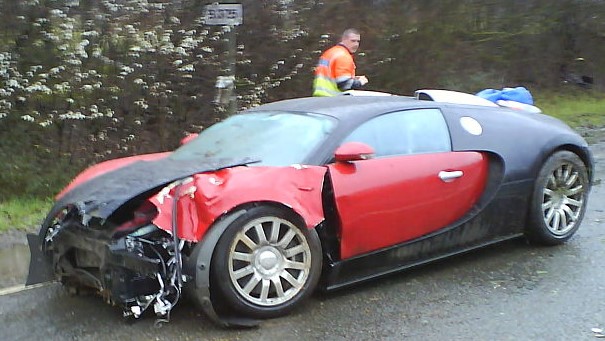
An awful lot of Veyrons have been crashed relative to the actual number found on the roads (i.e. excluding the “investment” Bugattis, the motoring equivalent of the gun world’s “safe queens”), and the same is true of all the hypercars. Even Rowan Atkinson, who is an excellent driver, managed to write off his Pagani Zonda.
I don’t even want to think of the accident rate among redneck hypercars, e.g. the Dodge SRT or the Camaro ZL1, both with plus-600hp engines.
Now I’m not saying that cars like this should be banned or restricted in any way (see my thoughts on powerful guns, above), but the question I want to throw out to you, O My Readers, is: what do you think is the engine (cylinder number, size, horsepower, whatever) that best serves the average driver? For the sake of discussion, let’s ignore trucks and SUVs, which may have different needs and uses, and concentrate on cars.
And to make it more interesting, let’s split it into four-door saloons and two-door sports cars.
My thoughts will appear below the fold, but avoid going there until you’ve worked out your own two examples.
Saloon Cars:
I’m going to go out on a limb here, and say that a 3.0-liter V6 with about 300hp is about the maximum most people would need. The horsepower is enough to carry four passengers and luggage without straining, and gives just that little extra oomph for highway overtaking. Here’s an example of a car which has all those, the Infiniti Q50:
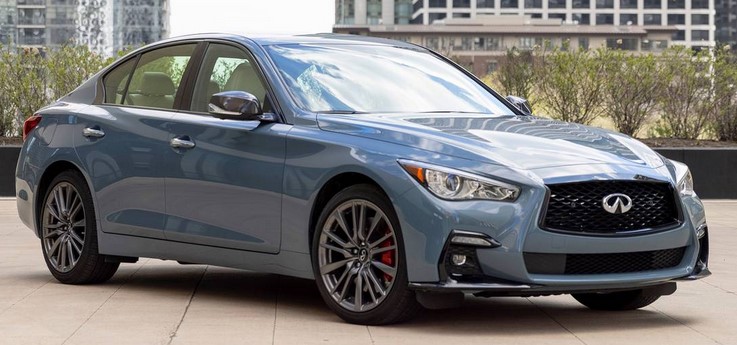
A 2.0-liter four-banger with 250hp would be likewise, if there’s a turbo to help it with the acceleration needs, e.g. the Mercedes C300:
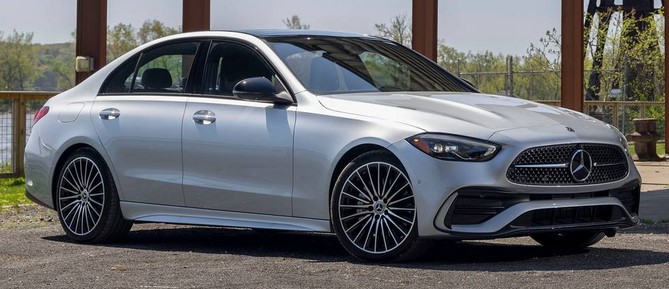
I would be perfectly happy to drive either of those cars as a daily drive and as a tourer.
Sports cars:
For a 2-door fun car, I’m not a believer in very powerful engines, because a smaller chassis doesn’t need 400hp to get it going, and adding a buddy/wife in the second seat doesn’t add that much extra weight either, even if your buddy is of my tonnage.
Frankly, I’m not sure that anyone’s going to argue with my prime example of such a car, the Mazda MX-5 Miata, with its 2-liter 180hp engine:
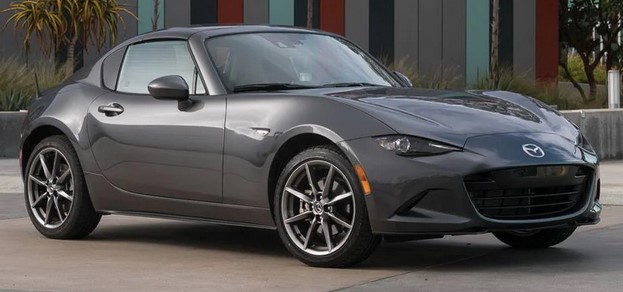
…and to be honest, I actually prefer the looks of the older MG/Lotus-inspired version:
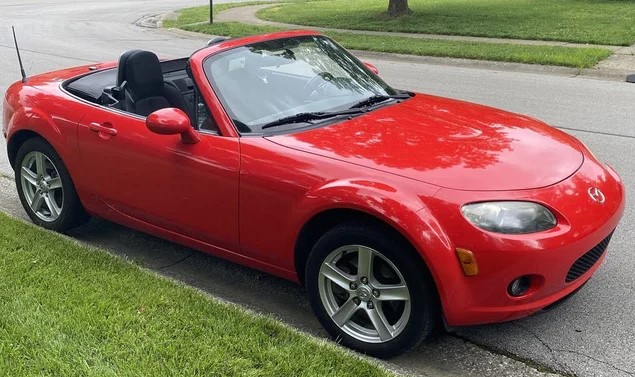
In the same vein as the older MX-5, and just to add a little spice to the mix, though, I’d also consider the older (and similar) Honda S2000:
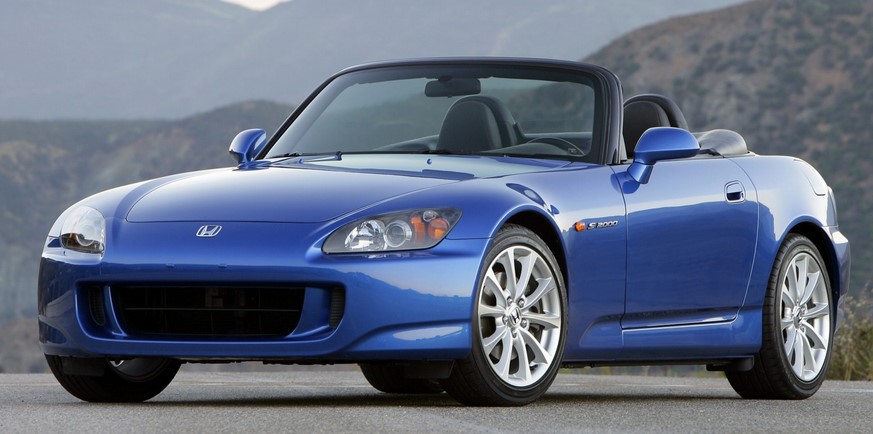
Why Honda stopped making this glorious little car is quite beyond me.
Anyway, I think you can see my drift on this topic. Next week, I’ll look at the same criteria, only in older (hobby) cars.

To me I think a 3.5L V6 would be a “best choice” regardless of the package it’s in.
I don’t care for turbos as they add too much complication to an otherwise serviceable engine.
> I don’t care for turbos as they add too much complication to an otherwise serviceable engine.
All else being equal, I suspect a larger, naturally-aspirated engine will last longer than a smaller, boosted engine as it’s under less stress.
That Ford Ranger I rented recently while my own car was in the shop did run like a scalded cat, though. Maybe forced induction is part of why rental cars are the fastest you’re likely to drive.
https://invidious.alfter.us/watch?v=ucQKNkvzQ3g
For 27 years I drove a 1989 Mustang with a 5 liter V8 putting out 225 horsepower. Given that the car was light (a bit under 3,000 lbs, lacking things like airbags) it’s hard to imagine anyone actually USING more power than that (I’ve written scholarly papers on wheel spin). With the weights of more modern cars I’d say 300-350 hp would be reasonable for any street car with street tires, whether sports car or four door.
Having said that, I think the problem with any performance car is people push them to their limit, and forget that the most important component is the nut between the steering wheel and the drivers seat back. Most people aren’t capable of handling a Honda Civic pushed to its limit, let along a car that can hit 140 with room to spare. Things just happen too fast at those speeds, and Isaac Newton will not be denied. It only takes a momentary lack of attention to cause a wreck, not to mention that even if you’re an expert there’s the guy who blew a stop sign because he was sexting while driving.
Mark D
I agree with Mark for the most part. His Mustang sounds like more than enough car for most people. For normal everyday driving you simply do not need massive horsepower so everything associated with it is going to waste. Since 1991 I have been driving an S10 with the smaller V6 and a 5 speed and shortly after getting it brand new I discovered that it’s maximum speed on the interstate was 88 mph. However, in the years since, never again did I drive that fast. Occasionally I’d go 70 on the interstate but I never felt like that little truck was underpowered. I will say though that I have not owned a vehicle with a V8 since 1984 and I surely would like to before I die. My ultimate choice would be a an All-American stock, mint condition, red, 1969 Mustang Mach I with the 428 CJ and a 4 speed. Then I could die with a smile on my mug.
For me, for a saloon, either a 3.0l V6 or a straight 6 3.0l
For a 2 door convertible sports car, straight 4 of approximately 2.0l, the MGB manufactured with modern methods and a leak proof hood would be mighty nice, if it came in Auto as an alternative that would be a bonus. The same spec. apart from a 3.0l engine would work very nicely in a Big Healey, (especially the manufactured with modern methods and a leak proof hood).
For a saloon, it’s hard to stick more than 400 hp on street tires in non-idea conditions, so that’s pretty much the upper limit. 300 hp is typically sufficient. 3.0 with super/turbocharging is enough.
For a sports car , the most fun to drive is something where it has just a little more power than the chassis can handle. For modern suspensions, they can handle a lot. 250 in a light car isn’t too much.
Tesla Model S – 650HP AWD (older model). All go, no show, even on leaf covered/damp pavement. Can put you in the headrest and hold you there like you are being hit with a water cannon, till your forebrain puts a stop to the madness. Zero wheel squeal or slip. Absolute near-perfect control of the car….
The magic of traction control in a electric vehicle, especially when the rear motor is AC induction. Induction motors are insanely easy to regulate for traction.
They use them in AC-drive locomotives for a reason!
Big fan of gas here — and piston engine can be this good, just nobody takes the time currently. The reason being, it is just not as simple, as it is with electric.
As the old movie quote says, “It depends on who’s in the saddle.”
I recall a trip to Germany many years ago where the rental was an E200, four speed. What a blast that was to drive around the autobahn and that vintage big-ass E200 made only 134HP.
My current ride, a 275HP Outback, is perhaps the perfect car, horsepower vs. practicality-wise.
So, 275-300HP also gets my vote as the sweet spot.
What, by the way, is this business with “saloon cars”? Does anyone actually drive these things any more, except perhaps in Jason Statham movies? I don’t get it. Not having owned such a thing since the 80’s, I thought we’d moved on
> what do you think is the engine (cylinder number, size,
> horsepower, whatever) that best serves the average driver?
For what? In what city? Driving around Albuquerque in the winter is going to need more of an engine than driving around Birmingham.
The “Average” driver mostly drives to get somewhere, be it commuting, errands, or vacation, and they’re best served by something that *doesn’t* encourage them to push their rater meager limits.
I say that as someone who’s eyesight and reaction times put them squarely in the “average” category. The only thing that makes me “above average” is knowing I’m average at most of it, and mitigating my average abilities with additional care and diligence.
You’re going to hate this, but the *average* driver is probably best served by an electric motor. This isn’t about the environment (because they’re mostly worse for the environment overall). They have maximum torque at low RPM, meaning they can accelerate up to a reasonable speed fairly quickly, and can accelerate fairly quickly from legal speeds if they need to get out of the way of something, but they get depleted *very* fast at the top end. Yeah, there’s a bunch of other problems with temperature etc. etc, but that’s not the motor, that’s the batteries.
An average driver can get almost everything they *want* to do with a naturally aspirated 1.6 liter 4 cylinder like the Nissan Versa. We have a 2004 Subaru Legacy wagon with a 165hp 2.5 liter that has towed a trailer with a large motorcycle, 100 pounds of ammunition and a bunch of other crap from California to Missouri, then to Denver at or above the speed limit most of the way. It doesn’t *quite* have enough power for my taste *above 6000 feet*, but it will do it, and frankly most people never get that high…
300hp? Too much for the average driver.
“300hp? Too much for the average driver.”
No argument from me, really. I’m quite comfortable with 200hp.
As someone who drove a 330GTC Ferrari (V-12, 4-litre, 300bhp) for almost 40 years (’76-’16) I found it to be almost perfect, and if it was coupled to one of the modern auto-transmissions (instead of that “terrible, gated 5-spd”/s), it would be a delight in a “saloon”; smooth, quiet, and yet responsive when the situation called for it to be.
While I once owned a Mustang V8, and greatly enjoyed the power of that car, I went instead to my wife’s minivan for a yardstick: a ’17 Toyota with the 3.5L V6. It has as much power as I or any other average driver may need, and it’s able to put that power to pavement even with the seats filled and a full complement of road trip luggage. While I know it’s neither a sports car nor a sporty “saloon” car (I have never understood that moniker), it’s the closest I currently have.
It was rated new as having a hair under 300 HP. 296, to be exact.
I am content with that.
My wife is perfectly happy with her daily driver 250 +/- something HP, 4 series BMW 4 door sedan with the turbo 4 cyln 4, which seems to have plenty of power for her needs and is a comfortable car on trips. I much prefer my 2 door 475 HP 3.8 liter flat 6 GT3, but it’s not my daily driver and while I can do ( tolerate ) long 800 mile per day drives in it, my wife wont.
…. and yes, it requires a certain level of restraint to drive what is essentially a Track day toy on the street. Since I get the opportunity to drive as it was intended to be used on a closed track, I have no need to drive it that way while on the street. It’s way too easy to drive it like an idiot on the street. You need to fight the temptation. You just need to be comfortable with knowing that you could if you wanted to but you choose not to. as the saying goes —- there are no Old , Bold Racing Drivers / Fighter Pilots / Bull Fighters etc..
” Even Rowan Atkinson, who is an excellent driver, managed to write off his Pagani Zonda. ”
Based on his history of also writing off several other high end cars, I’d say he fit’s into the standard “more money than skill” bucket of drivers, a rather large pool in my experience. Thats why the Porsche Club runs Drivers Ed events with trained instructors at our track days. The instructors are trained to identify the type — a common problem that can be mostly resolved. The ones who won’t learn are not invited back.
I have to take this from a personal point of view. I’m a mediocre driver, and keep the number of my accidents (2) as low as I do by remembering that fact almost all the time. I get all the ‘performance’ I seriously need out of a 2014 Subaru Outback, which (I looked it up) runs to 174hp.
Now, I’m not saying nobody needs more. I appreciate many cars as works of sculptural art, and kinda wish I had the reflexes (and bank account) to justify owning one. Let somebody who HAS the reflexes go ahead. And if he can only let it all out on a track day, well have fun!
People with highly powered cars do not, in my experience, cause me a lot of worrry. It’s people who learned to drive in little hatchbacks and who are now driving SUVs wider than the Queen Mary who scare me most often. They apparently have little or no conception where their wheels are.
I think you are looking at the question from the wrong perspective. It’s not really the amount of power so much as the lack of training of the average driver. The process that is used here in the US to get someone legal for the road does not impart any real appreciation of how a vehicle actually handles the various conditions that impact control.
That lack of training doesn’t even address the several categories of mental ability that the public consists of. The vast majority don’t really care about their lack of proficiency, if they even realize it. The problem might be mitigated to some extent if there was a very quick, clear example of how the lack of competency will get you killed or badly hurt, but that doesn’t really exist at this point. Driving a vehicle is probably the most intense endeavour that most people will ever engage in, and that could kill you, and they can’t be bothered to get good at it. Hell, even most pilots in Gen Aviation can’t be bothered to really learn as much as they can, and that kills them on a regular basis.
So, HP levels can get you in trouble a little quicker, maybe, but it’s not really the problem, from my perspective.
1 hp per 10 pounds of weight. That is a standard in airplanes so it should work in cars as well. It is a good idea to take your new driver out on a dirt road, or better gravel. Lean how to skid and other techniques you can learn in places where friction is mildly reduced.
But I also feel 90percent of the driving public shouldn’t so there is that.
Agreed — Learning how to drive with reduced traction should be an important part of driver training that is usually overlooked. and the result is plain to see right after the first snowfall every year.
Driver training doesn’t matter that much. Up here in Western Canada everybody, trained and experienced or not, drives like an idiot after the first snowfall. Me too, I’m sorry to say, but not as bad as some.
I drive a MX-5 RF exactly like the one in the pic. It’s got all the power I can use.
I drive an MX-5 RF exactly like the one in the pic. It’s got all the power I can use.
It is interesting that different cars can have different feels with regard to performance. My 1999 Civic (my last manual) only made 106 hp (and that at 6200 rpm) but never felt underpowered. Part of that was curb weight (2410 lb) and part of that was the redline for the engine was at 7000 rpm so you could always merge onto an expressway by pushing it in 3rd. My 2013 Outback, while much easier on my old knees, felt ponderous with 173 hp. Of course, it weighted 1000 lb more.
Here is my 2c FWIW.
Every person that wants to drive, must learn to do so on a 40HP or less stick shift automobile. Once they master that and can parallel park to perfection, they can graduate to the 150 HP or under range.
If accident and ticket free for 10 years, then whatever the can afford thereafter. No limit.
This is of course not idiot proof, there are far too many of those in the population, bell curve and all that.
The problem is really not so much power of the car as addled brains on drink, pot and distraction. I observe all 3 of those daily (sometimes in combination) with the way people drive in the Midwest.
Learned to drive stealing my dad’s ’72 beetle late at night. Later in driver’s ed at high school got to play with a ’74 Vega woodie wagon. No one else wanted to mess with a manual so it was mine, ALL MINE! Dunno why all the Vega-hate. Thought it was quite nice. Then I graduated, enlisted and hopped on to an M60A1, now there’s a car.
It’s only just occurred to me that I made my comments above while thinking of British Roads rather than American ones…..
The wife’s car, 2015 Buick LaCrosse, 300 hp V-6, has plenty of TORQUE to move out in a nice manner. Not a drag racer by any means, but when you push the pedal it has plenty of git movin’ torque. For a full sized car that’s more luxury than speed, that’s plenty. (Yes, I know you’re comparing some of them there furrin cars again, but the LaCrosse is the nicest sedan we’ve owned).
If I were to drive a full sized car instead of a pickup, I’d probably want 400 hp in something like a Dodge Charger. I don’t know what makes a “saloon” other that swinging doors and a bartender named Tex, so not sure what the other options are in that category.
But here in Texas, where we merge onto I-45 at 80+ mph in heavy traffic, in a construction zone, with a short on-ramp, you need at least 300 hp in order to survive the experience. Much more than that is wasted, much less leaves you no options for merging.
My wife’s ’97 Miata is old-old-school (flip-up headlights, finger-hole door latches) with a 1.6L 4-cylinder and a 5-speed manual. It develops a (rated) 89 HP at 6,000 RPM; we never rev it above 5,000 so we’re not even getting that out of it. On most straight line roads I consider it underpowered, and it’s terrible on the freeways.
But here in Wyoming on a twisty mountain road we can leave just about anything or anybody in the dust. About the only vehicles that have kept up with us are the pocket-rocket AWD Subies, and most of those are driven by kids who have no idea how to handle that much power other than in a straight line. It’s an absolute blast to drive the Miata on the twisties, and it never feels underpowered on those kinds of roads, even at almost 11,000 feet at the top of the Beartooth Pass.
So for a very light-weight two-door convertible less than 100 HP seems to be just fine as long as you’re driving on an appropriate road.
I’d say that I am an average to better than average driver, based on my total lack of moving (or parking) violations in the last 25 years, and the last accident I was involved with aside from wildlife running into me was more than 40 years ago…
Having said that, the only vehicle I own with fewer than 300 hp is my Mercedes 560SL, 1989 edition that spec’d at ~275HP. My Expedition (3.5L Ecoboost), 365 HP, my F250 and F350 Powerstrokes, all are more than 300 HP
So the limit should be higher…much higher, I think. Perhaps 400HP?
Never been much of a car guy, perfectly happy with a ’99 Bonneville followed by a series of Accords. When wife-unit passed September last year was on my way to church to plan funeral arrangements and ran a red light. Got t-boned and totaled the car. Got the insurance settlement and bought a ’19 Pilot. I can still hear wife-unit (too big! too expensive! I can’t step up that high!) Do I need something that big? Nope, But I like Hondas and it was the only Honda on my daughter’s car lot that day. Rides like a rutting truck but wottaya want. Daughter was the service manager but got the commish for the sale.
My ’68 mustang had the “baby eight” 289 that made 195 hp. That was a little bit light, I’m thinking the 265 or 325 hp models would have been a better call.
My 2013 Lincoln MKZ had the 3.7 V6 that generated 300 hp, that was just about right for most normal purposes, but again, felt a little bit light. There were situations where squeezing the required oomph out of the thing wasn’t as straightforwards as the old V8s, wherein you’d simply drop the hammer and Shit Would Happen Immediately, no matter what gear you were in.
IMO: The modern V6s actually look better on paper in terms of HP, Torque, and gase mileage than older V8 engines, which would simply brute force bully the laws of physics to produce their performance. There was really something to be said for that: those engines would produce their power magnificently, without hesitation or breaking a sweat, leaving plenty of headroom to spare. The modern engines have to spool way up towards the upper end of their range, and you have to downshift from like 9th gear to 4th to summon the giddyup.
Mr. Bean had the good taste to prang a McLaren. He wouldn’t have been seen dead in a Pagani Zonda. On his Top Gear appearance, if I remember rightly Rowan topped the list. I’d say that there is a definite amount of skill there.
If you have never raced a car I would strongly recommend you buy under 200 horses. You have to know how to cross the limit while staying in control. Kids in Finland can drift a car on ice before they can walk and to them black ice is considered a wee bit slippery. The rest of us would do well to keep it down on public roads to eighty per cent maximum of your limits and the car’s limits. When things go wrong they go wrong very quickly. High performance driving training is invaluable for those moments on the road where you suddenly realize that the shape of the situation approximates a pear. Instead of panicking you know that you can safely drive your way out of this.
It took me almost 50 years of driving, but a couple of years ago I discovered the perfect car: a BMW F10 in diesel trim. Our 535dx has a little over 300 hp, but has 464 lb/ft of torque. Torque is the thing.
I had a 2003 BMW 325i for a while. ~185 hp. It was plenty zippy for my driving. I think I had it in triple digits once. That was a little intimidating and I didn’t do it again. Was fun to drive on windy roads.
Still driving my 2004 Pontiac GTO – an Aussie Holden Monaro, actually – a 350hp torquey thing with the Corvette LS1 engine and Tremec 6 speed manual. Fun fun fun. Needs a bit more oomph, though. The Teslas beat me.